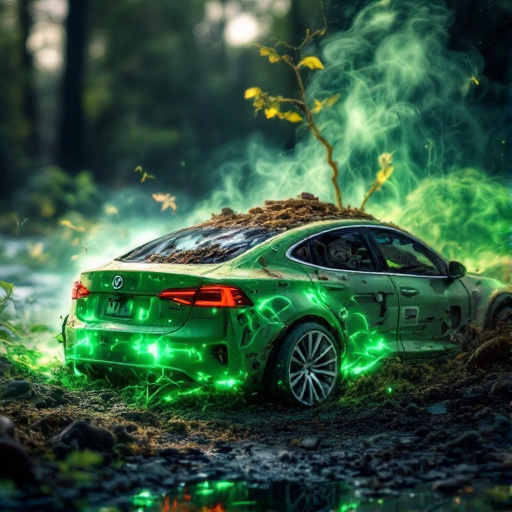Related Articles
- Charged Up! How Electric Vehicles are Reshaping Urban Wildlife Habitats and Biodiversity
- Navigating the Used Car Market: Uncovering the Secrets of 'As-Is' Sales for Savvy Buyers
- The Rise of Electric Car Pop-up Shops: A New Frontier for Urban Retail Experiences
- The Forgotten Art of DIY Car Maintenance: Rediscovering Skills in a Tech-Driven World
- Electric vs. Vintage: The Battle for Enthusiasts' Hearts in the Age of Latest Car Models
- The Rise of the 'Car Review Influencer': How Social Media is Shaping Auto Buying Decisions
Revving Up Sustainability: How Junk Cars are Fueling the Electric Vehicle Revolution
Revving Up Sustainability: How Junk Cars are Fueling the Electric Vehicle Revolution
In a world increasingly focused on sustainability, junk cars have emerged as a surprising catalyst for the electric vehicle revolution. Their recycling not only helps to minimize waste but also provides valuable materials crucial for building electric cars.
The Road to Revolution: Understanding Junk Cars
Everyone has seen that rusty old car sitting in someone's driveway, slowly succumbing to the elements—a rusty testament to yesteryear's transport solutions. According to the Automotive Recyclers Association, around 12 million cars reach the end of their life cycle in the U.S. each year. That's a lot of metal, rubber, and plastic that could otherwise be taking up space in a landfill. But what if I told you that these junkers are more than just a nuisance? They are becoming integral to the future of sustainable transportation.
Statistics Speak Volumes
Let’s toss some numbers on the table: in 2021, the global electric vehicle market valued at approximately $163 billion was projected to reach nearly $800 billion by 2027, growing at a compound annual growth rate (CAGR) of around 18%. To meet this rising demand, manufacturers require an ample supply of critical minerals—many of which can be salvaged from junk cars. When recycled effectively, a single junk car can yield significant amounts of aluminum and steel, as well as precious metals like platinum, gold, and palladium found in catalytic converters. It’s not just garbage; it’s a treasure trove waiting to be unearthed!
Every Junk Car Tells a Story
Picture this: a teenager inherits their first car, a clunky but beloved sedan. Fast forward a decade, and that same car is a pile of scrap metal in the backyard, a stark reminder of bad decisions made during college road trips. But instead of hauling it off to the junkyard with a heavy heart, what if the owner knew that car could help power the next generation of vehicles? A simple exchange at a recycling facility could mean that the car would play a role in making new electric vehicle batteries.
The Cycle of Materials
At the heart of this recycling phenomenon lies lithium, a key ingredient in electric vehicle batteries. Did you know that lithium can be harvested from old batteries? With nearly 300 million vehicles projected to be on American roads by 2030, recycling doesn't just keep junk cars from the landfill; it closes a critical loop in the material cycle. Instead of mining more lithium from the earth—which is expensive and harmful to the environment—the recycling of old cars and batteries can meet future demands.
Casual Conversations among Car Enthusiasts
As my neighbor Jerry, a die-hard car enthusiast, often muses, “Every car has a purpose, even when it's sitting in my yard getting a little rusty." Indeed! Why not grab a beer and talk about how we can give old vehicles new lives? An afternoon barbecue can become a brainstorming session about sustainable practices, and who knows—maybe that junk car sitting idle could one day power an electric vehicle!
Case Study: The Transformation of Detroit
The city of Detroit, known as the Motor City, has been at the forefront of not only automotive innovation but also car recycling initiatives. Companies like Detroit-based Recycle Industries have started programs to turn junk cars into usable parts for electric vehicles. They work directly with automakers, ensuring that the materials derived from these junk vehicles are returned into the manufacturing process. This symbiosis between recycling and manufacturing is a model for urban regeneration, reducing environmental impact while also creating jobs. According to a recent report, recycling efforts in Detroit alone could reduce CO2 emissions by over 2 million tons annually!
Challenges Along the Way
However, not all is smooth sailing in the recycling highway. The process of dismantling cars and extracting useful materials can be fraught with logistical challenges, not to mention regulatory hurdles. For instance, certain components of older vehicles—like asbestos or hazardous fluids—require special handling to avoid environmental hazards. As we rev up for an electric future, tackling these challenges with innovative approaches is essential. Companies are investing in better technologies to optimize the recycling process, ensuring that we aren't just salvaging cars, but doing so in a safe and sustainable manner.
Persuasion: Why It’s Time to Act
So let’s stop the eye-rolling at those “clunkers” in driveways. The narrative surrounding junk cars needs a revamp. If you own an old vehicle, consider the potential impact of recycling—not just for your wallet but for the environment. For every car that you recycle instead of letting languish in your backyard, think of the critical materials that can help construct an electric vehicle, perhaps even one that could revolutionize transportation in the future!
Collaboration is Key
In the midst of this automotive revolution, collaboration between automakers, recyclers, and consumers becomes imperative. Car manufacturers are beginning to recognize the value of recycled materials, and programs that promote taking back end-of-life vehicles are on the rise. Initiatives such as Ford’s “Take Back” program and GM’s “Building for Tomorrow” prioritize sustainability and the smarter use of resources, steering the entire industry towards a greener trajectory.
A Humorous Take on the Junkyard
Ever notice how junk yards have a certain charm? It’s where dreams go to die, or perhaps, be reborn! There’s something poetic about a Volkswagen microbus sitting next to a Ford Pinto, both waiting to be transformed into the electric cars of tomorrow. Just imagine the conversations they’d have if they could talk. “Remember that summer road trip to the beach?” “Oh, don’t get me started on oil leaks!” Maybe we should install a “Junk Car Reunion Party” sign outside these yards! After all, every clunker has a funny story to tell.
Conclusion: Join the Movement
As we look forward to the future of transportation, it’s essential for individuals, policymakers, and companies alike to recognize the role junk cars will play in fueling the electric vehicle revolution. By embracing recycling, we are not just clearing out old vehicles; we are investing in a sustainable future that honors the past while breathing life into the innovation of tomorrow. Whether you’re 16 or 70, the next time you see that old jalopy in the yard, remember: it could very well be a building block for an electric vehicle that revolutionizes your daily commute. Let’s rev up sustainability together!




